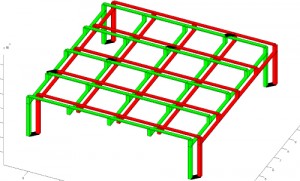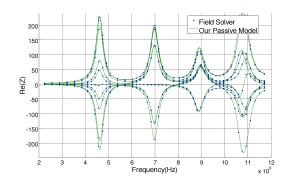Passive Compact Dynamical Modeling via Semidefinite Programming for MULTIPORT Interconnects

Figure 1: 3D layout of the distribution grid (not to scale) showing Vdd (red or dark grey) and Gnd (green or light grey) lines. Black strips represent locations of ports.
Automatic generation of accurate, compact, and passive models for multiport interconnect structures is a crucial part of the design process for circuits. Conventionally, interconnect structures are laid out in a field solver and simulated for frequency response in the desired frequency band. Based on the frequency samples extracted by the solver, a reduced model is developed. This model can be incorporated into a circuit simulator for time-domain simulations of a larger system also containing nonlinear devices. A small violation of any basic property of the structure, such as passivity, can cause huge errors in the response of the overall system, and the results become completely nonphysical. Therefore, it is essential to preserve basic system properties during the model identification. To model multiport structures from given frequency-response samples, the only available approach so far is to identify a stable, but non-passive, model, and then perturb the model to make it passive [1] [2]. However, such approaches suffer from limitations if the initial non-passive model has significant passivity violations.

Figure 2: Comparing real parts of frequency response from our passive model (solid line) and from the field solver [3] (dots). This plot demonstrates the accuracy of our identified models by showing a close match with given field-solver data.
In this work we propose a new technique for passive modelling of multiport interconnect structures. Given transfer-function samples, we identify a rational transfer-function reduced model that minimizes the mismatch at the given frequencies subject to a global passivity constraint. After a convex relaxation, this problem is formulated as a semidefinite optimization problem, which can be solved efficiently using existing techniques. Numerical results are presented for a power distribution grid (shown in Figure 1) and an array of inductors having 8 and 4 ports, respectively. Figure 2 provides a comparison for accuracy between our identified passive models and given data from a field solver [3].
References
- S. Grivet-Talocia, “Passivity enforcement via perturbation of Hamiltonian matrices,” Circuits and Systems I: Regular Papers, IEEE Transactions on, 51(9):1755–1769, Sept. 2004. [↩]
- S. Grivet-Talocia and A. Ubolli, “A comparative study of passivity enforcement schemes for linear lumped macromodels,” IEEE Trans. On Advanced Packaging, 31(4), Nov. 2008. [↩]
- T. Moselhy, Xin Hu, and L. Daniel, “pfft in fastmaxwell: A fast impedance extraction solver for 3d conductor structures over substrate,” In Proc. of Design, Automation and Test in Europe Conference, 2007.DATE ’07, pages 1–6, April 2007. [↩] [↩]